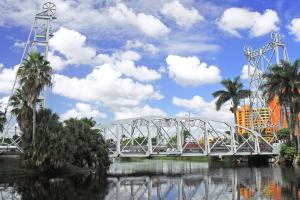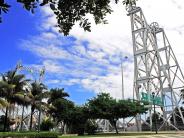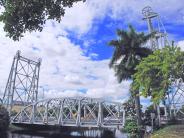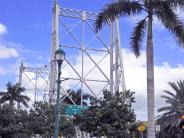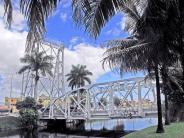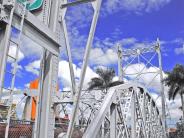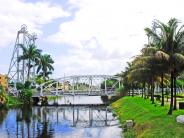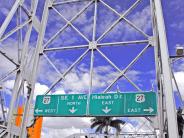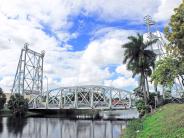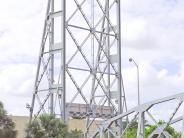Parker Vertical Lift Bridge (outgoing)
PARKER VERTICAL LIFT BRIDGE
(outgoing)
Spans the Miami River Canal between Hook Square and Okeechobee Road
Designated Miami Springs Historic Site (1992)
Just downstream of the Warren Pony Swing Bridge, stand the twin spires of the Parker Vertical Lift Bridge. Originally sited downstream at 36th Street, it was floated upriver on a barge and relocated to this location in 1954 to carry an increasing volume of outgoing traffic across the Miami (C-6) River Canal.
Two existing boat basins for recreational craft were hand-dug in the nearby canal bank in the mid 1920’s, and saw heavy usage by early Country Club Estates/Miami Springs residents, with the northernmost one mostly utilized by small outboard skiffs, row boats and canoes, and the southernmost (near the Parker Truss Vertical Lift Bridge) used for larger pleasure craft. The current “River Cities Festival” held every April in Miami Springs had its start as the “Miami Regatta”, later called the “River Cities Regatta”, and originally involved an annual flotilla of community watercraft. Substantial photographic documentation of this event and also the variety and amount of river traffic pre-1940 may be viewed in the Miami Springs Historical Museum.
With the installation of the South Florida Water Management District’s S–6 Saltwater Control Dam just downstream of 36th Street, commercial navigation of this area came to an end. However, recreational use continues to the present day, although accessibility is impeded by disrepair of the basin areas and the unimproved canal bank. Fishermen are a common sight along the canal bank and basins, children delight in feeding the ducks and other waterfowl in the area, and manatees have been sighted in the vicinity of this bridge several times.
The Parker Vertical Truss Bridge was constructed in 1927 by the Champion Bridge Company of Wilmington, Ohio. It is 74.5 feet high and 158.2 feet long, spanning a distance of 132 feet. The bridge roadbed was, like the nearby Warren Pony Swing Bridge, originally covered with wooden decking. Twin towers on each bank support a vertical rail structure that allowed the whole bridge to be raised vertically to allow the passage of large river-going craft. Massive steel and concrete counterweights were used to balance the weight for efficient raising and lowering of the bridge by a system of wheels and pulleys. Each original counterweight weighed about 125,000 pounds. They were removed in 1983 because there was no longer any need to raise the bridge to allow large boat traffic to pass. It is believed that the counterweights were buried intact in a berm on the Hialeah side. This bridge retains its original integrity of design, materials and workmanship, and is well-maintained except for two modifications: besides the removal of the counterweights and drive machinery, the wooden deck surface was covered with asphalt in 1981.
Click any thumbnail image to view a slideshow

